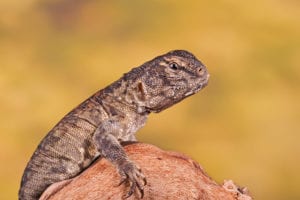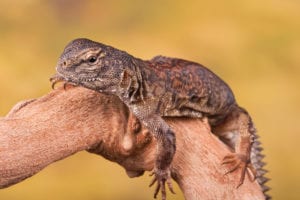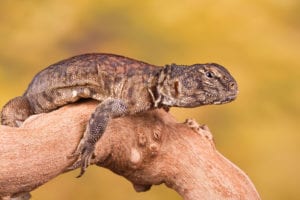 Uromastyx acanthinurus, as a species occurs throughout North Africa, more or less around the Sahara Desert. This sub-species is allocated to occurring in Morocco, but there is much confusion around this species and its several sub-species (and with many of the other Uromastyx species for that matter). It grows to around 45cm long, females perhaps slightly bigger – males are often said to be brighter coloured and have a broader head. They occur in desert areas, favouring softer earth that will clump so they can burrow – but do occur in rocky areas, cliff faces and other areas where they can jam themselves in crevices rather than making burrows. They are primarily herbivorous eating a wide range of desert plants,
Uromastyx acanthinurus, as a species occurs throughout North Africa, more or less around the Sahara Desert. This sub-species is allocated to occurring in Morocco, but there is much confusion around this species and its several sub-species (and with many of the other Uromastyx species for that matter). It grows to around 45cm long, females perhaps slightly bigger – males are often said to be brighter coloured and have a broader head. They occur in desert areas, favouring softer earth that will clump so they can burrow – but do occur in rocky areas, cliff faces and other areas where they can jam themselves in crevices rather than making burrows. They are primarily herbivorous eating a wide range of desert plants, leaves, succulents etc – but they will eat ants and beetles, especially when young.
leaves, succulents etc – but they will eat ants and beetles, especially when young.
To keep this species as an adult a sizeable vivarium will be required. A solo adult will require a very bare minimum of a four feet long vivarium – preferably bigger. They do climb, so a minimum of two feet tall is recommended – with the addition of some climbing branches and perhaps a purpose-made ‘cliff face’ back wall. We use a mixture of ProRep Bio Life Desert substrate and Zoo Med Excavator clay substrate to cover the vivarium floor and allow for burrowing. We sometimes spray parts of these substrates to provide localised humidity and simulate desert dawn dew. Other hides and décor is provided (and of course a food and shallow water bowl).

All Uromastyx species prefer very high temperatures, aim for a basking area of around 40C – but it is critical when providing such high basking temperatures that the vivarium is big enough (and well planned out) to provide cooler areas of around 25-30C. Otherwise over heating and death can occur quickly – please be careful. Likewise too cool a temperature will cause health problems and death, but at a slower rate. Uromastyx will tolerate many temperatures (as to be expected of a species that occurs in an area with such extreme variations of temperature (they both hibernate and aestivate in the wild)), but this is for the very experienced keeper to attempt in captivity.
Lighting and heating is therefore super critical for this species. There is huge debate on both topics, with keepers being fanatical (to the point of being rabidly so) to their belief. It’s fair to say you will require a form of at least one heater in the hot end of the vivarium to maintain the 40C basking temperature. Various heaters will do this from halogen, ceramic and incandescent heaters – our own preference being ceramic heaters. Any choice of heater must be controlled with an accurate thermostat to avoid over-heating. Some keepers provide multiple basking heaters in large vivaria. Lighting is best provided with a high quality T5 UVB light tube from the likes of Reptile System or Arcadia – up to 15% UVB is available and suited to this species and far superior to the old fashioned T8 UVB tubes.
One of our all time favourite lizard species, highly recommended – especially for those that do not like the though of feeding their pet with live insects.
